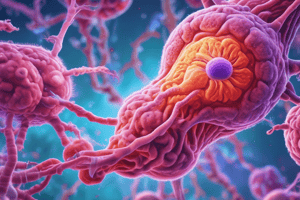Podcast
Questions and Answers
What is the primary characteristic of lobar pneumonia?
What is the primary characteristic of lobar pneumonia?
- It primarily affects individuals with strong immune systems.
- It involves patchy consolidation of lung tissue.
- It typically involves an entire lobe of a lung. (correct)
- It affects only the bronchi and bronchioles.
How does bronchopneumonia typically manifest in the lungs?
How does bronchopneumonia typically manifest in the lungs?
- By the presence of numerous discrete inflammatory lesions.
- As a uniform consolidation of the entire lung.
- In dependent portions of lung tissue with patchy consolidation. (correct)
- Through the formation of protein-rich hyaline membranes.
What primarily characterizes interstitial pneumonia?
What primarily characterizes interstitial pneumonia?
- It occurs exclusively in immunocompromised individuals.
- It has significant exudate accumulation in the alveoli.
- It primarily affects the alveolar walls and connective tissue. (correct)
- It leads to extensive edema throughout the lungs.
What is a notable feature of miliary pneumonia?
What is a notable feature of miliary pneumonia?
What is the primary function of the enzymes during the resolution of lobar pneumonia?
What is the primary function of the enzymes during the resolution of lobar pneumonia?
What is the most common causative organism for community-acquired pneumonia?
What is the most common causative organism for community-acquired pneumonia?
Which of the following accurately describes bacterial pathogens in pneumonia?
Which of the following accurately describes bacterial pathogens in pneumonia?
How does aspiration of gastric contents lead to pneumonia?
How does aspiration of gastric contents lead to pneumonia?
What distinguishes opportunistic pneumonia from other types?
What distinguishes opportunistic pneumonia from other types?
What pattern is typically observed on radiographs in cases of viral pneumonia?
What pattern is typically observed on radiographs in cases of viral pneumonia?
How do noninfectious causes of pneumonia differ from infectious ones?
How do noninfectious causes of pneumonia differ from infectious ones?
Which differentiates healthcare-associated pneumonia from community-acquired pneumonia?
Which differentiates healthcare-associated pneumonia from community-acquired pneumonia?
What impact does a lower pH of aspirated material have on the airway?
What impact does a lower pH of aspirated material have on the airway?
Flashcards
Lobar Pneumonia
Lobar Pneumonia
Affects an entire lung lobe, marked by fluid buildup and lung consolidation due to immune response.
Bronchopneumonia
Bronchopneumonia
Involves patchy lung consolidation, mostly in bronchioles, with less fluid in the air sacs.
Interstitial Pneumonia
Interstitial Pneumonia
Inflammation primarily targets lung tissue's walls, not the air sacs initially, causing gas exchange issues.
Miliary Pneumonia
Miliary Pneumonia
Signup and view all the flashcards
Lung Consolidation
Lung Consolidation
Signup and view all the flashcards
Infectious Pneumonia
Infectious Pneumonia
Signup and view all the flashcards
Noninfectious Pneumonia
Noninfectious Pneumonia
Signup and view all the flashcards
Bacterial Pneumonia
Bacterial Pneumonia
Signup and view all the flashcards
Viral Pneumonia
Viral Pneumonia
Signup and view all the flashcards
Aspiration Pneumonia
Aspiration Pneumonia
Signup and view all the flashcards
Community-Acquired Pneumonia
Community-Acquired Pneumonia
Signup and view all the flashcards
Healthcare-Associated Pneumonia
Healthcare-Associated Pneumonia
Signup and view all the flashcards
Opportunistic Pneumonia
Opportunistic Pneumonia
Signup and view all the flashcards




